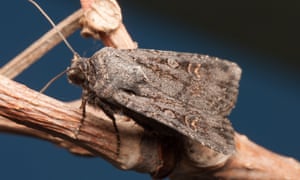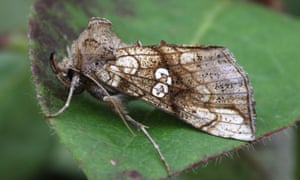Moths in Britain have declined in abundance by a third over the past 50 years, according to a study.
The declines of 39% in the abundance (relative representation in an ecosystem) of larger moth species over southern Britain and a 22% fall across northern Britain add to the picture of calamitous declines in flying insects in the industrialised world.
Among the most rapidly declining of Britain’s 900 larger moth species are the stout dart (-81% over an average 10-year period), the golden plusia (-58%) and the garden dart (-54%).
“This decline is worrying because moths play a vital role in our ecosystems,” said Richard Fox of Butterfly Conservation, which produced the report with Rothamsted Research and the UK Centre for Ecology & Hydrology. “They are pollinators of many plants, with some wildflowers, such as orchids, relying on visiting moths for reproduction. They also provide essential food for thousands of animal species, including bats and many familiar birds.”

The report gathers millions of records from moths caught in light traps by the Rothamsted Insect Survey and the National Moth Recording Scheme from 1968 to 2017. When the data was last analysed up to 2007, it revealed a 40% decline in southern Britain – south of Lancaster and York – but no overall change to moth abundance in northern Britain.
Fox said the 22% decline in abundance now recorded in northern Britain over the 50-year-period was “a real concern”.
He said: “A whole bunch of moth species are spreading northwards in Britain, driven by climate change, and the north is the recipient of that benefit. But the fact that there is a significant decline in overall abundance in the north is very worrying.”
According to Fox the prime driver for the declines is likely to be habitat loss and more intensive agriculture, including chemical farming, but other important factors include climate change and, possibly, increased nitrogen deposition and light pollution.
“No species will be totally immune from all these different factors,” he said. “Even moths living at the top of a Scottish mountain will be impacted by climate change and nitrogen deposition.”
Increasing levels of nitrogen deposited via rainfall due to car emissions and other pollutants are causing certain robust plants to crowd out more delicate plants and flowers on which specific moth caterpillars depend.
Dan Blumgart, moth ecologist at Rothamsted Insect Survey, said: “Comparing this latest State of Britain’s Larger Moths to the first edition in 2006, it is a disappointment that the situation has not improved. It is clear that a much bolder policy of habitat protection and restoration will be needed if British moths are to thrive well into the future.”

There are winners as well as losers. The Devon carpet moth has expended from south-west Britain to reach southern Scotland in 2013, its range shifting northwards by 9.9 miles (16km) a year in recent years. Its abundance has soared by 526% over 50 years.
The Jersey tiger moth is another species that was once confined to Devon but has spread rapidly over southern Britain, crossing the Bristol Channel into Wales in 2008. Its distribution across Britain has increased by 861% since 1990.
According to Fox, positive developments for moths include the hope that post-Brexit financial support for farmers will be based around “public money for public goods” which could incentivise more nature-friendly farming, and afforestation efforts as long as it is “the right tree in the right place”.
“Another hopeful sign is people’s interest in and awareness of moths and our scientific knowledge of the importance of moths – particularly in pollination – has really grown since the last report,” said Fox. Suppliers of moth traps – which enable people to humanely identify-and-release moths in their garden – sold out during the spring lockdown last year, and local moth groups reported bumper sighting records being submitted to them.
“There are a lot of winners as well as a lot of losers among the larger moths,” added Fox. “This is more evidence that insects in general are declining but they are not about to go disappear altogether. Worrying insect decline rather than insect apocalypse is the way I would phrase it.”
Average Rating